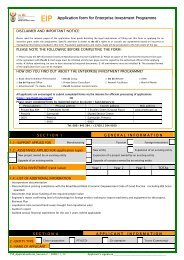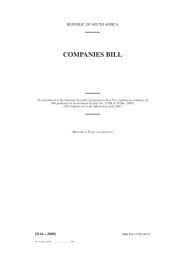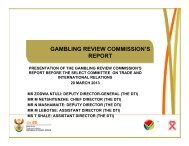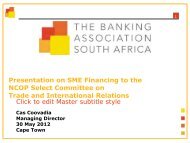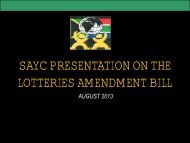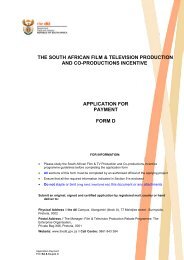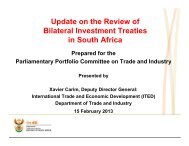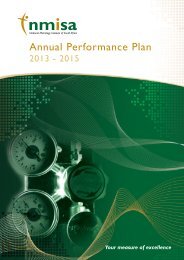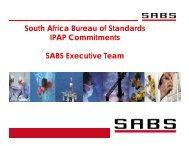Copyright Review Commission Report - ICT Law and Regulation ...
Copyright Review Commission Report - ICT Law and Regulation ...
Copyright Review Commission Report - ICT Law and Regulation ...
- No tags were found...
Create successful ePaper yourself
Turn your PDF publications into a flip-book with our unique Google optimized e-Paper software.
efore it, in accordance with the provisions of the Uniform Rules of Court of the Supreme Court of South Africa(now the High Court).3.1.18. As noted in paragraph 2.2.5 above, the MITT identified what it described as the major problems of the musicindustry. These included “inadequate <strong>and</strong> outdated copyright legislation, particularly with regard to needletime”(needletime gives performers the right to receive remuneration when their recordings are broadcast, transmittedin a diffusion service or communicated to the public). It referred to the fact that, unlike composers <strong>and</strong> authors,performers enjoyed no copyright protection. It pointed out that this lack of protection was “out of keeping withinternational trends in which needletime regulations are the norm”. It also said that South Africa's non-accessionto the Rome Convention was anomalous <strong>and</strong> that “[t]he absence of needletime legislation [was] one of the keyobstacles to the development of local music <strong>and</strong> the music industry”. It accordingly recommended that a draftamendment prepared by the St<strong>and</strong>ing Advisory Committee on Intellectual Property “should be implementedwithout delay”. The recommendation continued:The MITT is unanimous in its concern about the length of time that this issue has been under discussion. Itrecommends that time frames be incorporated into the amendment of the Act, providing for negotiations between thebroadcasters on the one h<strong>and</strong> <strong>and</strong> the producers <strong>and</strong> performers on the other h<strong>and</strong>, regarding the establishment of theappropriate rate. [In a footnote, it added that there was “a minority view that the time restriction should be at thediscretion of the Minister rather than written into the Act”.] Should agreement not be reached within the stipulated timeperiod, the Minister of Trade <strong>and</strong> Industry is asked to intervene.3.1.19. In 2002, Parliament accepted the MITT's recommendation that legislation be amended to provide for royalties tobe paid for needletime. It passed two Acts, one amending the Performers' Protection Act by, inter alia,substituting a new Section 5, <strong>and</strong> the other amending the <strong>Copyright</strong> Act by, inter alia, substituting a new Section9 <strong>and</strong> 9A. (The texts of the new Sections 9 <strong>and</strong> 9A of the <strong>Copyright</strong> Act <strong>and</strong> the new Section 5 of thePerformers' Protection Act are set out in Appendix 4A.) The effect of the amendments may be summarised asfollows:The new Section 9 of the <strong>Copyright</strong> Act gives to the holders of the copyright in sound recordings exclusive rightsto broadcast or authorise the broadcasting of their sound recordings, their transmission in diffusion services <strong>and</strong>their communication to the public. The new Section 9A in effect gives users who broadcast a sound recording,transmit it in a diffusion service or communicate it to the public, a statutory licence to perform these acts,provided they pay royalties to the owners of the relevant copyright (i.e. the copyright under Section 9 (c), (d) or(e)). The cost of the royalty is to be agreed between the user <strong>and</strong> the owner of the copyright <strong>and</strong> the performeror their representative collecting society or, in the absence of such an agreement, determined by the <strong>Copyright</strong>Tribunal or an arbitrator to whom the question was referred by the parties. The owners of the copyright whoreceive payment of royalties under the section are obliged to share the royalties with any performer whoseperformance is featured on the recording in question <strong>and</strong> on whom a right to receive a royalty is conferred bySection 5 of the Performers' Protection Act. The performer's share is to be determined in terms of an agreementbetween the copyright holder <strong>and</strong> the performer or their representative collecting societies. In the absence ofsuch agreement, the determination is to be made by the <strong>Copyright</strong> Tribunal or an arbitrator to whom the partieshave referred the matter. Sub-section (3) of the new Section 5 of the Performers' Protection Act in effect givesusers of commercial recordings a statutory licence to broadcast, transmit in a diffusion service or communicateto the public these recordings, provided they pay the performers royalties agreed between the users <strong>and</strong> theperformers or their representative collecting societies, or in the absence of such agreement determined by the- 17 -



